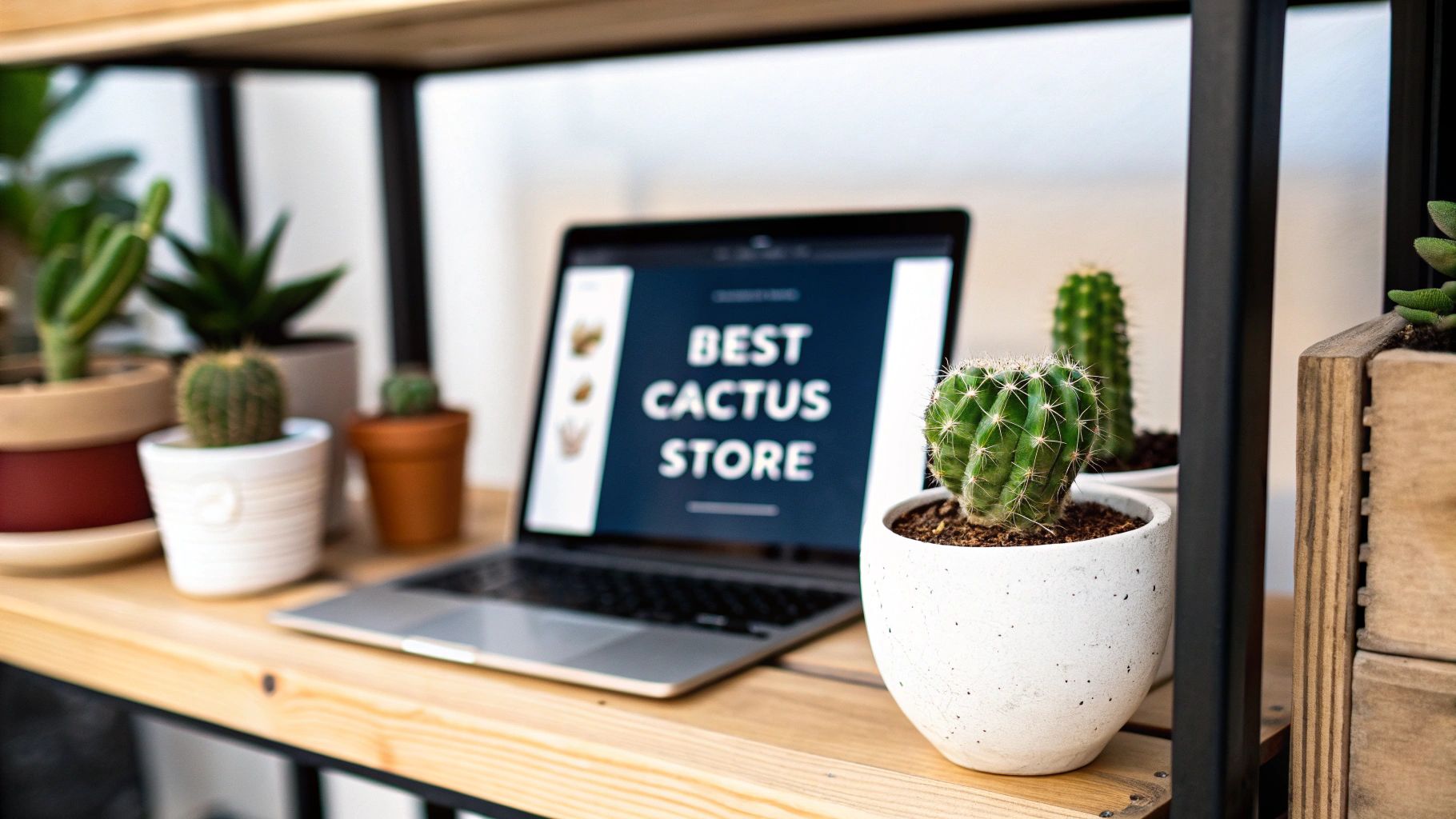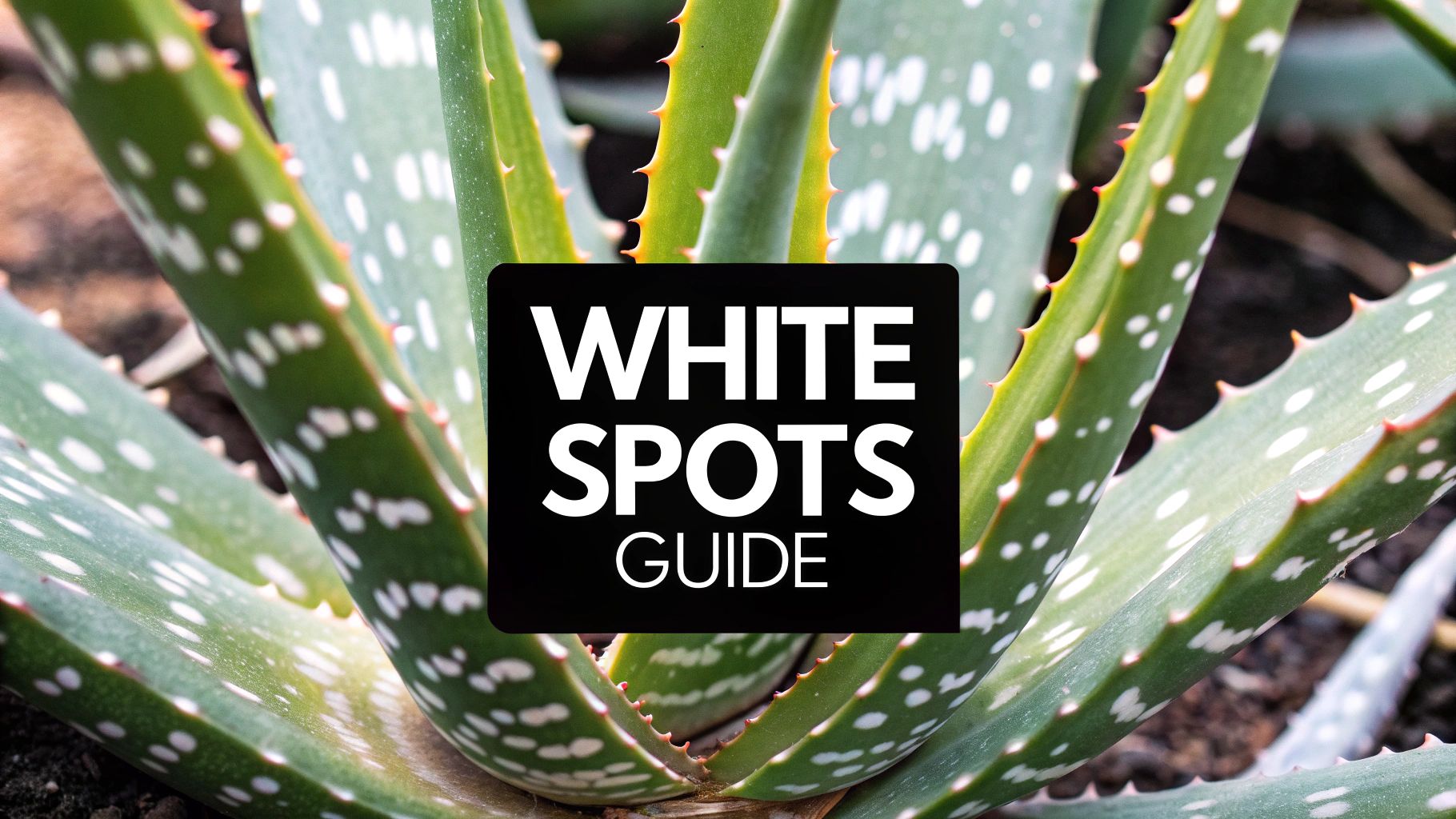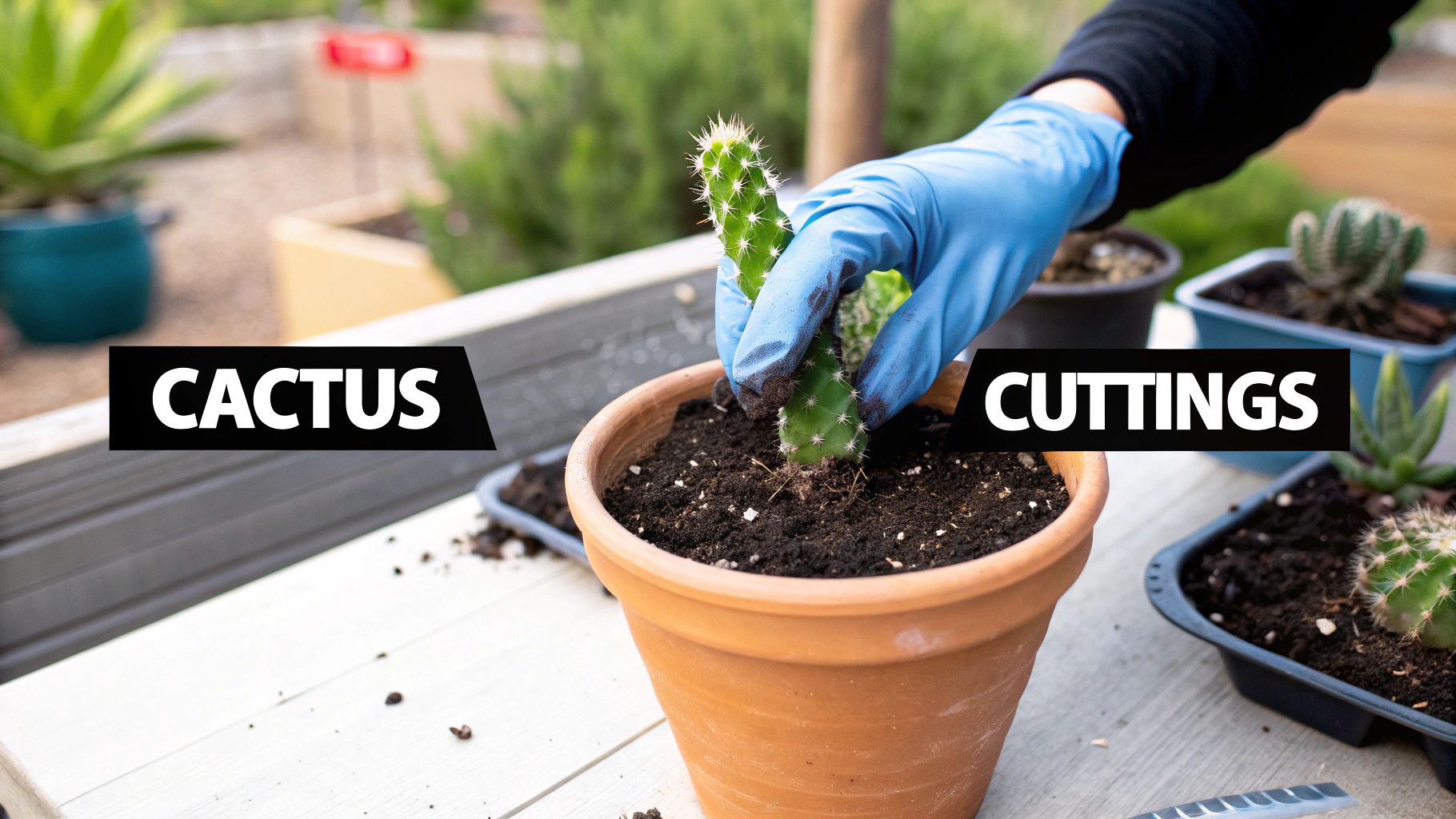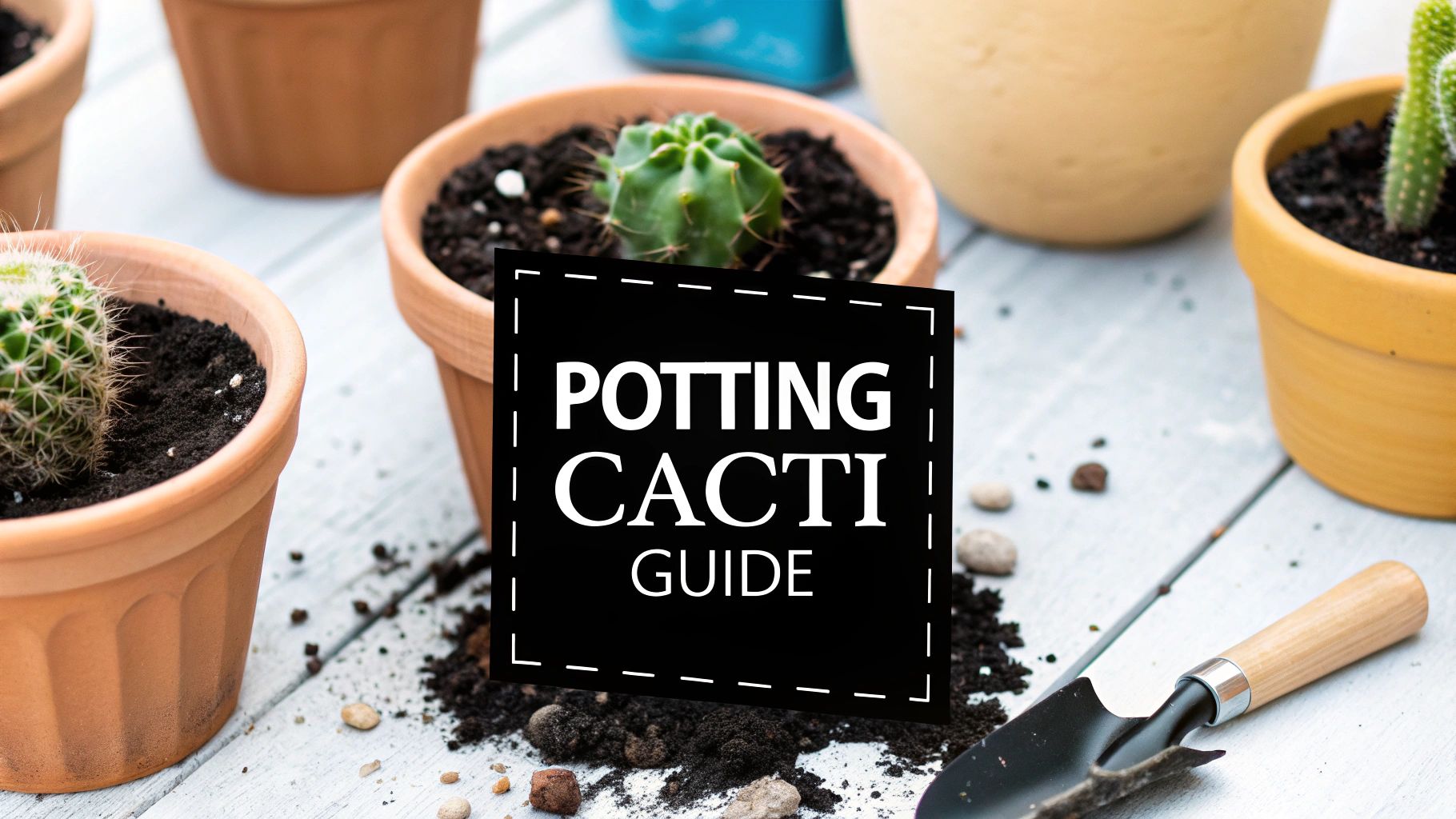While big-name plant shops like The Sill or Bloomscape are solid starting points, the best online cactus store really boils down to what you’re looking for. It's a personal choice.
The right seller for someone dipping their toes in with a simple San Pedro is worlds away from where a seasoned collector might hunt for a rare Ariocarpus. It all depends on your priorities—be it rare species, rock-bottom prices, or absolutely bulletproof shipping.
What Really Makes an Online Cactus Store Great?
Let's be honest, finding a reliable online source for cacti can feel like navigating a minefield. With so many sellers out there, how do you spot a top-tier nursery and avoid a risky gamble? It’s about so much more than just pretty pictures on a website.
A truly great retailer invests in the entire experience, from meticulously cultivating healthy plants to ensuring they land on your doorstep, alive and well.
The e-commerce boom has been a huge boost for the global succulent and cactus market, thanks to a growing obsession with low-maintenance, eye-catching houseplants. This digital shift gives us more options than ever, but it also means we need to be smarter shoppers. You can learn more about this market growth and what it means for consumers.
The Hallmarks of Quality and Trust
So, what are the non-negotiables? I have a mental checklist I run through before I even think about adding a plant to my cart. These are the fundamental green flags that tell me a business genuinely cares about its plants and its customers.
Before you buy, look for these tell-tale signs of a trustworthy store:
- Vibrant, Healthy-Looking Plants: The photos should show plump, well-colored cacti. Watch out for signs of stretching (etiolation), pests, or significant scarring.
- Crystal Clear Policies: A store should be upfront about its shipping details, return policy, and live-arrival guarantee. If you have to dig for this info, consider it a red flag.
- A Solid Reputation: What are real people saying? Positive buzz on forums like Reddit's r/cactus or in Facebook plant groups often paints a more accurate picture than hand-picked website testimonials.
The true measure of a great online store isn't just selling you a cactus. It's delivering a healthy, correctly identified plant that was packaged with enough care to survive the journey. That shows respect for both the plant and for you as a customer.
To help you size up potential sellers quickly, I've put together a simple table. Think of it as a cheat sheet for spotting the best of the best.
Key Indicators of a Top-Tier Online Cactus Store
Use this quick reference to evaluate online cactus retailers at a glance.
| Evaluation Criteria | What to Look For |
|---|---|
| Plant Selection & Photos | Clear, recent photos of the actual plants for sale. A diverse inventory with accurate botanical names. |
| Pricing & Value | Transparent pricing without hidden fees. Fair market value for the size and rarity of the species. |
| Shipping & Packaging | Multiple shipping options, including heat packs for cold weather. Mentions of careful, secure packaging methods. |
| Customer Service & Policies | An easy-to-find contact method. Clear return policies and a "live arrival" guarantee are essential. |
| Reviews & Reputation | Positive, recent reviews on third-party sites (Google, Reddit, Facebook). Active and helpful social media presence. |
Keep these points in mind, and you'll be well on your way to finding a fantastic online nursery that you can rely on for years to come.
How to Judge Plant Quality and Selection Online
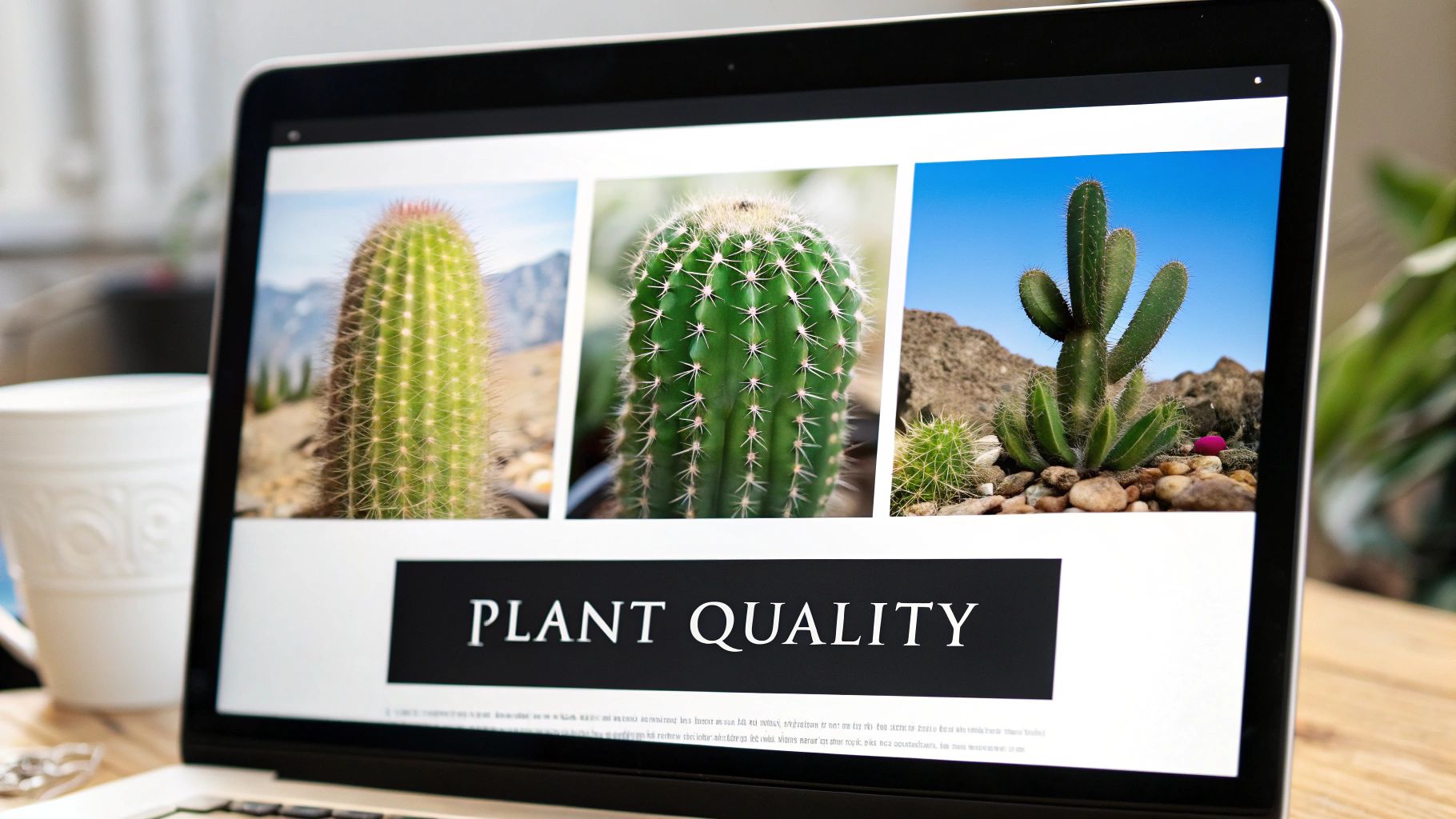
Think of browsing an online cactus shop as a digital treasure hunt. The best ones aren't just selling plants; they're curating a collection. A great retailer will have something for everyone, from the first-timer looking for a classic Saguaro to a serious collector chasing a rare, crested variety.
When you see a deep, diverse inventory, that’s a fantastic sign. It usually means the seller is a true enthusiast, not just a middleman flipping plants. They're invested in the hobby, and that passion translates to better quality for you.
Spotting a Healthy Cactus from a Photo
Beyond the sheer number of plants available, the quality of the listings tells you everything you need to know. You have to put on your detective hat and really scrutinize the product photos for clues about the plant's health. You're looking for vibrant colors, plump and firm stems, and a strong, upright structure. These are the tell-tale signs of a happy, well-cared-for cactus.
It’s actually pretty simple to spot potential problems, even from a picture. Once you know what to look for, the red flags become obvious.
Keep a sharp eye out for these common issues:
- Etiolation (Stretching): Does the cactus look like it’s pale and skinny, desperately reaching for the sun? That’s a sign of poor growing conditions, which often means a weaker plant.
- Pest Damage: Zoom in. Look for tiny white cottony spots (mealybugs), fine webbing (spider mites), or what looks like tiny brown scabs (scale insects).
- Discoloration: Any yellowing or mushy brown spots, especially near the base, can signal root rot. That's a killer, and it's incredibly difficult to save a plant from it once it takes hold.
A reputable seller will always use clear, well-lit photos of the exact plant you're buying. Be wary of listings that only use a single, perfect "stock" photo or have a disclaimer like "plant may vary." The best growers are proud of their plants and want to show you precisely what you'll get.
With the global cactus products market projected to hit $2.8 billion by 2032, more and more sellers are popping up online. This boom, which you can read about in market trend reports, makes it more crucial than ever to be a savvy buyer who can spot true quality.
Pay attention to the little details, like how the plants are named. A shop that uses proper botanical names (e.g., Echinocactus grusonii) instead of just "Golden Barrel" demonstrates real expertise. It shows they know their stuff.
The same goes for shops that offer detailed care guides or sell different options like cuttings. These are signs of a deep passion for the craft. If you're curious about that, check out our guide on if you should buy a cactus cutting online.
Cracking the Code on Shipping and Packaging
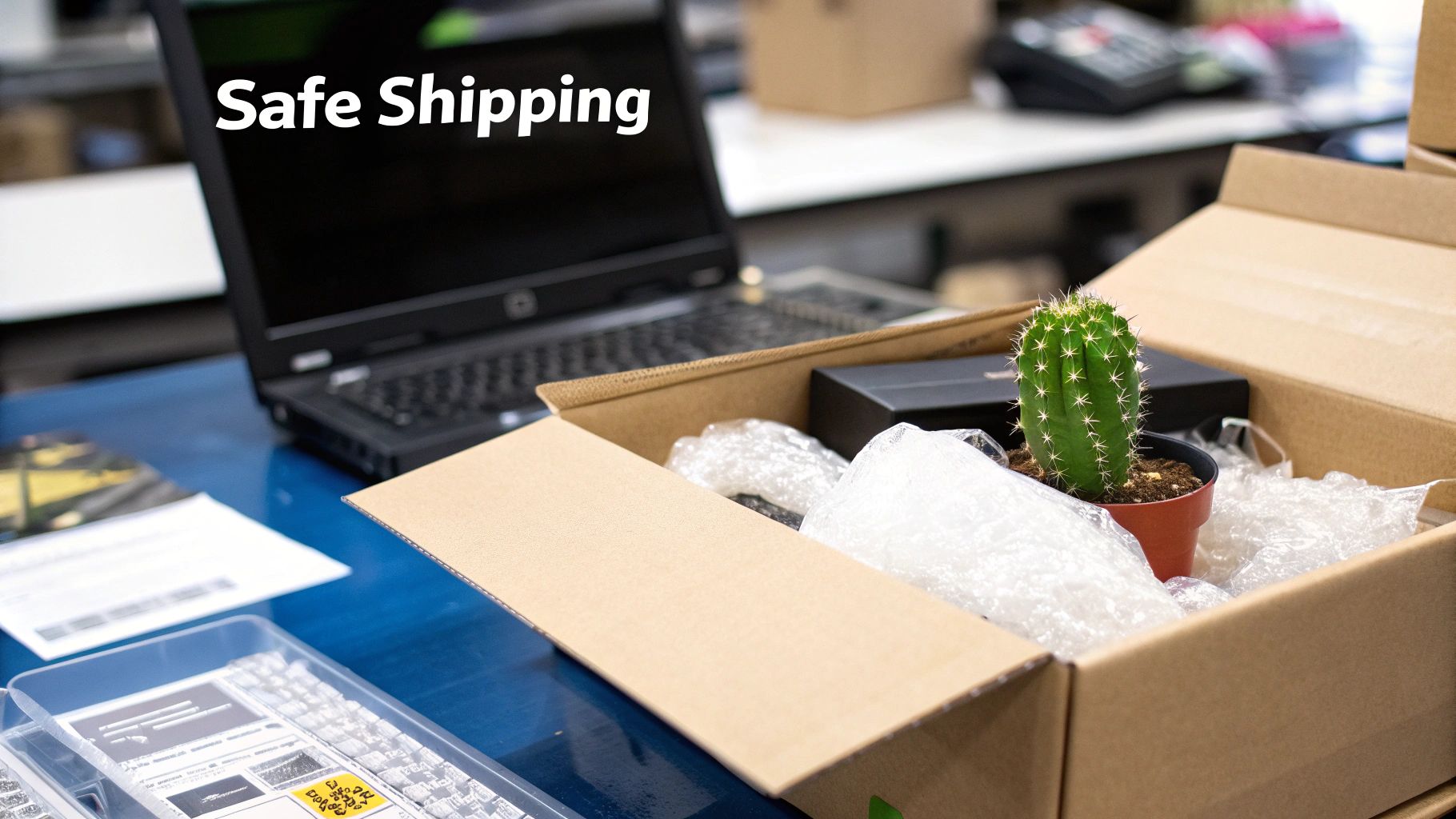
You can find the perfect cactus online, but the most perilous part of its journey is the trip from the seller’s greenhouse to your home. I’ve seen it happen too many times: a gorgeous plant gets destroyed by careless packaging, and all that excitement turns to disappointment. The best online sellers know that getting the plant to you safely is just as critical as growing it.
Proper packaging is a true art form. It's not about just chucking a plant in a box and crossing your fingers. The pros use specific techniques and materials to make sure your new spiky friend arrives in one piece.
What Great Packaging Actually Looks Like
While finding a cheap courier service is part of a seller's logistics, the delivery company can only do so much. The real magic is in the packing. When you open that box, you should immediately see signs of expert care.
Here’s what I look for to know a seller is legit:
- A Secure Root Ball: If the cactus is potted, there should be tape or a cardboard collar holding the soil in place. For bare-root plants, the roots are usually wrapped gently in paper to keep them safe and sound.
- Spine Protection: This is a big one. The best shippers use soft materials like poly-fil, shredded paper, or even cotton balls to cushion delicate spines and prevent them from breaking or poking through the box.
- Weather-Proofing: Any seller worth their salt will offer insulated wrapping and 72-hour heat packs in the colder months. Seriously, this is non-negotiable if you want to avoid receiving a frozen, mushy mess.
Don't be turned off by a slightly higher shipping fee. It often means the seller is using quality materials and taking the time to pack your plant with care. Paying a few extra bucks for a heat pack or a sturdy box is a tiny price to pay for a cactus that arrives alive and well.
Bare-Root vs. Potted: What's the Deal?
You'll notice many shops send their cacti bare-root, meaning completely out of the pot and soil. Don't panic! This is a common and often safer way to ship them.
Shipping without a heavy pot of soil cuts down on weight (and cost!) and dramatically reduces the risk of root rot during transit. Plus, it gives you a fantastic chance to check out the root system yourself before you pot it up in your own mix.
Good stores are transparent about their methods. Always check their shipping and returns page for the details on how they handle things. For a solid example of how this should be done, take a look at the Cactus Outlet’s shipping details—they lay it all out clearly for their customers.
Putting Customer Service and Store Policies to the Test
Let's be real—even with the best packaging in the world, things can go sideways. A box gets dropped, a heat pack fails, or a plant just decides it's had enough of being in the dark. This is where a seller’s customer service and store policies become your absolute best friend.
A great online cactus shop doesn’t just ship you a plant; they stand behind it. They have clear, fair policies that protect you when your new plant arrives looking more sad than spiky.
Before you even think about clicking "add to cart," go on a little scavenger hunt for the store's policies page. A reputable seller will have their live-arrival guarantee, return policy, and instructions for damage claims right out in the open. If you have to dig through five layers of menus to find it, or the language is super vague, that’s a big red flag.
How to Test the Waters Before You Buy
Here’s a little trick I always use: ask a pre-sale question. It's a fantastic way to see what you're getting into.
Just send a quick email or use their contact form to ask something simple. "I'm in zone 7b, should I add a heat pack this time of year?" is a perfect example.
Their reply (or lack thereof) tells you everything you need to know.
- Speed: Did you get a reply within a business day? That's a good sign. Days of silence? Not so much.
- Quality: Was the answer genuinely helpful, or did it feel like a canned, copy-paste response that didn't really address your question?
- Vibe: You can tell a lot from the tone. A friendly, helpful reply shows they actually care about their customers and their plants.
This simple five-minute test gives you a real-world glimpse into how they'll treat you if a real problem comes up down the road.
Think of a store’s policies as their promise to you. A solid live-arrival guarantee means they're confident in their plants and their shipping methods. If the policies are weak or missing, you're likely on your own if something goes wrong.
Check Their Real-World Reputation
Don't just rely on the glowing five-star reviews plastered on their own website. You need to do some real digging.
Head over to third-party platforms like Reddit (check out r/succulents or r/cactus) or search for the shop's name in Facebook plant groups. This is where you'll find the unfiltered truth. Look for posts where people talk about how the seller handled problems. Did they quickly replace a cactus that arrived rotten? Or did they ghost the customer after getting their money?
Imagine this scenario: your new Astrophytum arrives and you immediately spot signs of root rot. An excellent seller will ask for a few pictures and offer a replacement or refund, no questions asked. A sketchy one might try to blame you or the shipping carrier.
As online shopping continues to grow, now accounting for around 35% of sales in many niches, customer service is what separates the good from the great. You can discover more insights about e-commerce distribution channels to see just how critical this is. Your peace of mind is worth finding a seller with a proven track record of happy customers.
Your Pre-Purchase Checklist and First Day Home
So, you’ve narrowed down the contenders and are ready to pull the trigger. Before you hit "buy," do one last quick rundown. Pit your top choices against each other, weighing their selection against the final price tag—that means factoring in shipping and any extras like a heat pack. It’s also a good idea to give their live-arrival guarantee one final glance.
Here’s a pro tip I’ve learned the hard way: take a screenshot of the product listing right before you order. This gives you a personal record of exactly what you were supposed to get, which can be a lifesaver if the plant that shows up doesn't match the picture.
Once that box lands on your doorstep, the real fun begins.
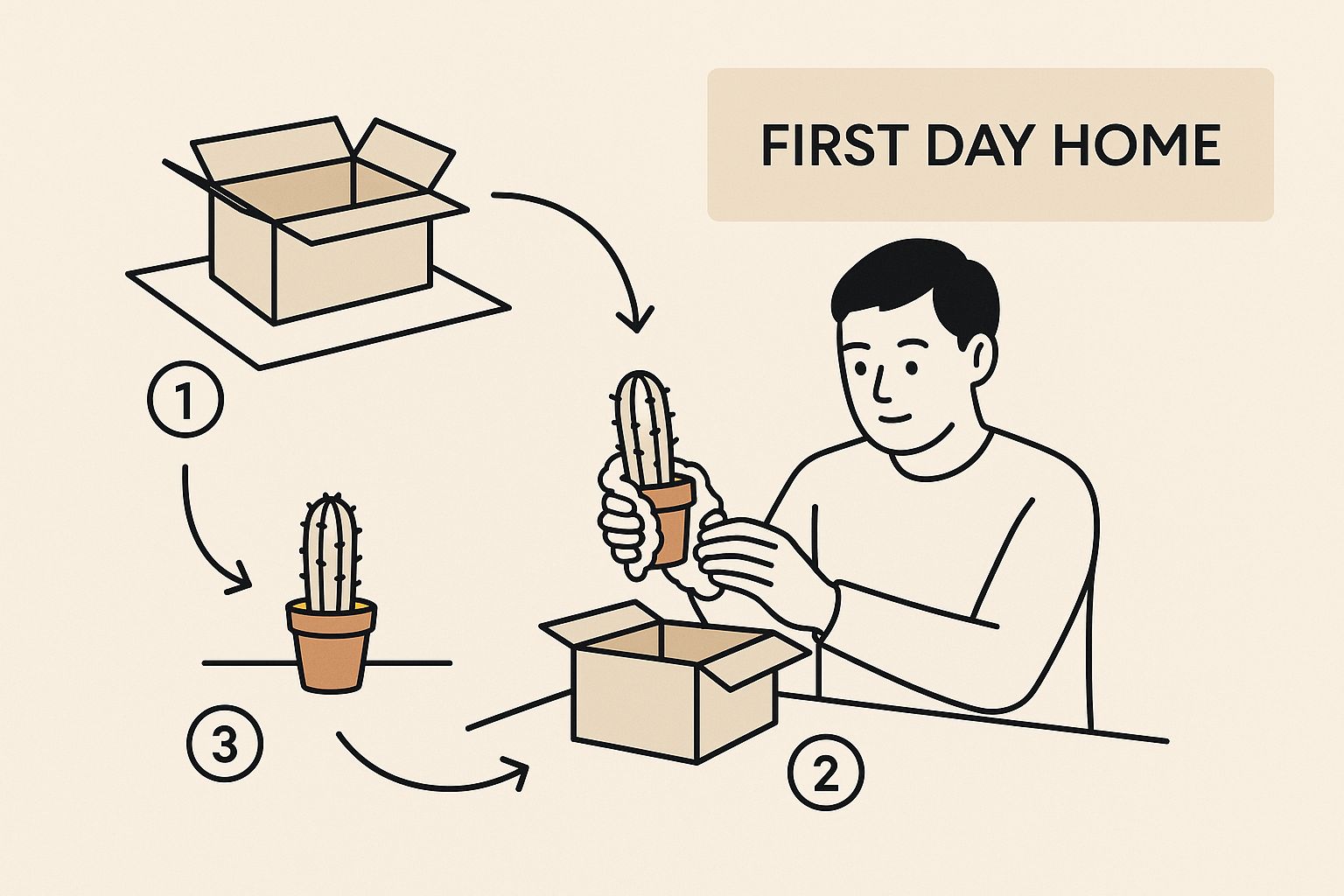
The first 24 hours are all about being gentle and observant. Your new cactus just took a long, dark trip in a box, so a little TLC goes a long way in helping it bounce back from shipping stress.
Acclimating Your New Arrival
After you've carefully unboxed your new plant, fight the temptation to water it or stick it in the sunniest spot you have. Just like us after a long trip, it needs a little time to decompress.
- Do a Quick Health Check: Look the plant over carefully. Check the stems for any pests or discolored, mushy spots that might signal rot. If it arrived bare-root, give the roots a gentle inspection, too.
- Give It Some Breathing Room: For the first week, place your cactus in a spot with plenty of bright, indirect light. Direct sun can scorch a stressed plant. This lets it slowly get used to the light and humidity in your home.
- Hold Off on the Water: This is a big one. Wait at least 5-7 days before you even think about watering. Any roots that were bruised or broken during shipping need time to callous over. Watering too soon is a fast track to root rot.
Frequently Asked Questions About Buying Cacti Online
Buying cacti online for the first time can feel a little bit like a trust fall. You're putting your faith in a stranger to send a living, spiky thing through the mail. It's totally normal to have questions. Getting good answers is what separates a great experience from a disappointing one.
Let's tackle some of the most common worries I hear from fellow collectors.
What About Shipping in Extreme Weather?
One of the biggest concerns is seasonal shipping. Can you really order a cactus during a Minnesota blizzard or an Arizona heatwave? With the right seller, the answer is a resounding yes.
A reputable shop will be watching the weather like a hawk. They'll use insulated boxes and heat packs to keep your plant cozy in the winter. For summer, they’ll recommend faster shipping options to get it off a hot truck and onto your porch ASAP. Before you buy, always look for a clear seasonal shipping policy on their site.
Potted vs. Bare-Root: What’s the Difference?
You’ll see cacti shipped two ways: potted in soil or bare-root with no soil at all. What’s the best choice?
- A bare-root cactus is often the preferred method for serious growers. Shipping without soil is lighter, drastically cuts down the risk of rot during transit, and gives you a chance to inspect the entire root system the moment it arrives.
- A potted cactus seems more convenient, but it can be messy and, more importantly, might hide underlying root problems.
For the control and peace of mind it offers, most experienced enthusiasts I know prefer their plants to arrive bare-root.
The single most important tip I can give you is to act fast if your plant arrives in bad shape. A good seller's live-arrival guarantee is your best friend, but it's almost always time-sensitive. Take photos of the box and the plant immediately—before you do anything else.
Have more specific questions? A good shop will have a detailed help section. We've put together answers to many other common concerns on our FAQ page.
Thinking beyond a single plant to your whole garden is part of the fun. If you're passionate about creating a sustainable and beautiful outdoor space, you might find some great ideas in these drought-resistant lawn alternatives and xeriscaping concepts.
Ready to grow your collection with confidence? At The Cactus Outlet, we offer a massive selection of healthy, high-quality cacti shipped with the utmost care. Find your next spiky friend today at https://www.cactusoutlet.com.

